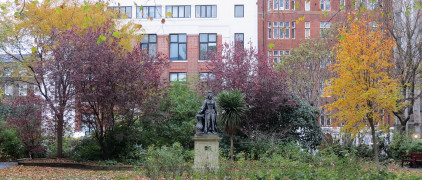 Queen Square, Bloomsbury.
Queen Square, Bloomsbury.
Queen Square is of interest to these pages for the lead statue, thought to represent Queen Charlotte, wife of George III, the monarch who was confined for a period in a house in the Square while he was treated for insanity. As well, there is a modern group of mother and child, and the Church of George the Martyr at the south end of the Square which has minor exterior sculpture.
The Square itself dates from the 1700s, and had a famous artistic resident in William Morris, who lived at no.26 from 1865, using his house as well to run his art production company, Morris and Co, through to the 1880s; but this residence no longer survives.
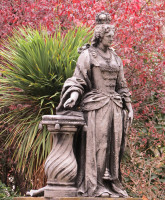
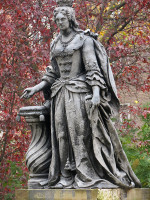 Two views of lead statue, thought to be Queen Charlotte.
Two views of lead statue, thought to be Queen Charlotte.
The statue of Queen Charlotte, previously thought to be that of Queen Anne, and believed to have been erected in 1775, is made of lead, once common for statues, but which passed out of use by Victorian times, apart from its use in ornamental garden statues, something of a fashion in the later 18th Century, and revived periodically later on. It is an attractive material, giving a white cast where the light falls, and looking blueish or blackish or almost beige depending on the light; very different in aspect from bronze. Being soft and heavy, it allows for fine detail, but tends to slump under its own weight, so that as well as internal support, lead statues tend to need external support too, hence the short pillar supporting the drapery on the Queen’s arm, and the solidity of the lower figure.
There are several of these pre-Victorian statues of Queens in London, generally of uncertain provenance and no record of the sculptor, generally wearing enveloping clothing, richly embroidered or otherwise decorated, always standing, and with complex hairstyles and crowns. The Queen stands leaning rather forward, likely because of the lead drawing it forward than because it was originally planned that way. Her face is rather solid, rather round, rather featureless except for the mouth, which is almost smiling. Her hair, by contrast, has its texture and ringlets and curls carefully delineated. She wears earrings, and two double chains of cut stones around her neck, one with a pendant cross. Further cut stones are on her embroidered bodice. Below this stiff garment, her skirt, patterned with flowers in low relief, is gathered at the waist with a tied drawstring, which hangs down at the front to two tassels. She has multiple sleeves, and her cloak comes forward to hang over one arm and to be held by her other hand. The free hand, nicely modelled, seems to be pointing, as if in conversation to emphasise some point. The best aspect of the statue is from the front and somewhat to the right, where the folds of the drapery show to great advantage; the profile view shows the aforementioned leaning forward. As noted, her sleeve drapes rest for structural reasons on a sort of a pillar, almost in the shape of a pot, with round lower part and thinner neck, heavily fluted, and with a tasselled cushion on top.
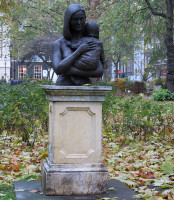 Patricia Finch's Andrew Meller memorial, 2001.
Patricia Finch's Andrew Meller memorial, 2001.
In great contrast, by the central path on a small plinth is a bronze group of Mother and Child, purchased by the Friends of Children of Great Ormond Street Hospital in memory of Andrew Meller, dating from 2001 and by the sculptor Patricia Finch, who is perhaps best known for her statue of a resting girl with flip-flops in Golders Hill Park (see this page). Decent modern work, the unsentimentalised half-figure of the mother cradling the infant in one arm, the other resting lightly on his back, his head resting against her shoulder.
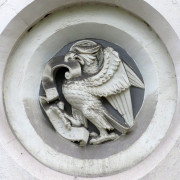
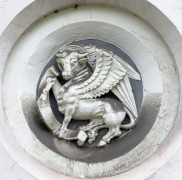
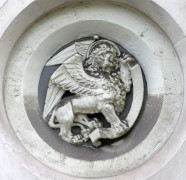
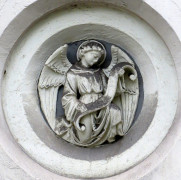 Carved religious animals and angel, symbol of the Evangelists, St George the Martyr.
Carved religious animals and angel, symbol of the Evangelists, St George the Martyr.
At the south west corner of the Square stands St George the Martyr, built 1706 to the designs of the architect Tooley. It was given two workovers in the 19th Century, firstly by J. B. Papworth, who added the tower, and later by Teulon, who apparently gave the Church its current exterior aspect. It is of interest as it was bought by the fund for 50 new churches set up in Queen Anne’s time, one of those cases where the Commissioners bought a church rather than having it built. On the front to the Square are stone angels, unusually coloured, and four roundels in high relief showing an eagle, winged bull, winged lion, and angel (the symbols irrespectively of Matthew, Mark, Luke and John), each nicely fitted within the circle and each with a small scroll. (For various pictures of angel sculpture, see this page.) Along with St George's Holborn, it shared the graveyard which today forms St George's Gardens.
The buildings around the Square include a couple of taller Queen Anne style edifices, and one more modern building has a couple of quatrefoils including one carved with an eagle, and labelled ‘St John’ and this statue of a saint above the door.
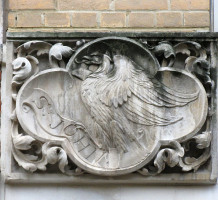
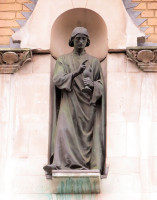 Sculpture on building in Queen Square.
Sculpture on building in Queen Square.
South and west to Bloomsbury Square // East and North to St George's Gardens
Visits to this page from 13 Mar 2014: 13,534